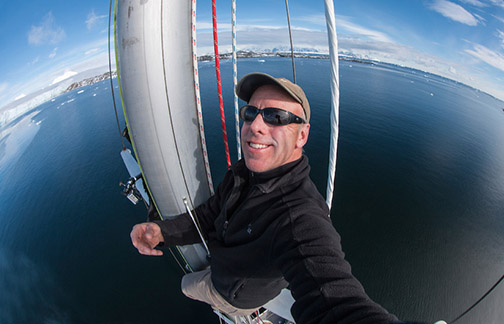Spotlight on Paul Souders
Feb 6, 2014
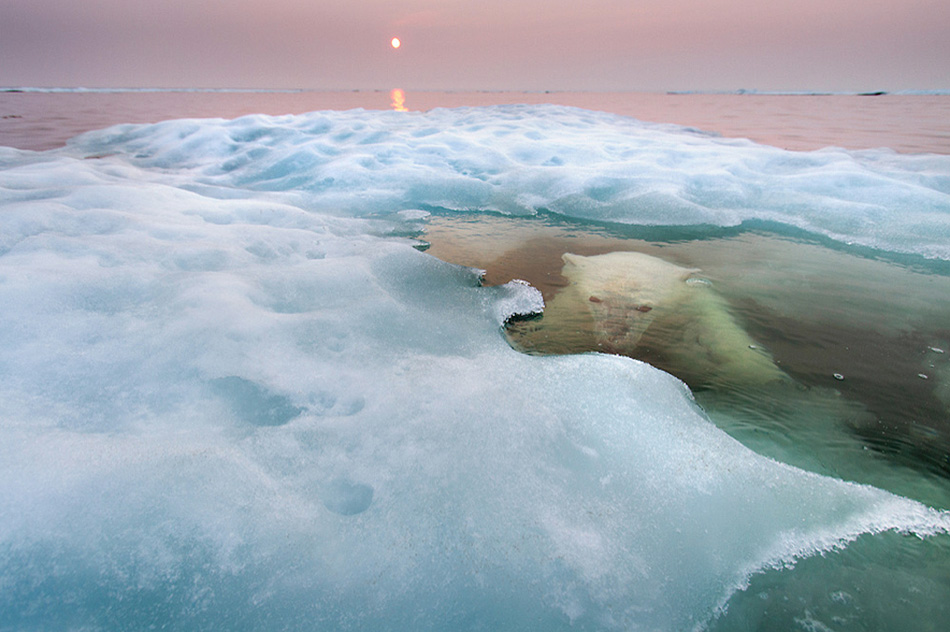
TID: Please tell us about the image's context and background.
Paul: I've wanted to photograph polar bears for years. I started in Svalbard, chartering steel-hulled sailboats and cruising around the high arctic, spending thousands of dollars for the pleasure of standing up on deck for endless hours in the biting cold, freezing slowly while scanning the pack ice for the slightest hint of a polar bear. Even as my shipmates sat downstairs warming their toes and sipping hot chocolate. When a bear was spotted, everyone would jockey for position on deck, and we'd all make the same pictures. It's a good introduction. But now I wanted to strike out on my own.
I thought about the polar bears of Hudson Bay. I knew that Churchill, Manitoba is home of the Tundra Buggy and the birthplace of mass polar bear tourism. I'm glad it's there; thousands of people have been able to see these incredible animals in the wild. All well and good, but I wasn't sure I'd be able to break much new ground while rumbling across the tundra in a bus filled to overflowing with tourists and other photographers. I wanted to show the bears in a new way.
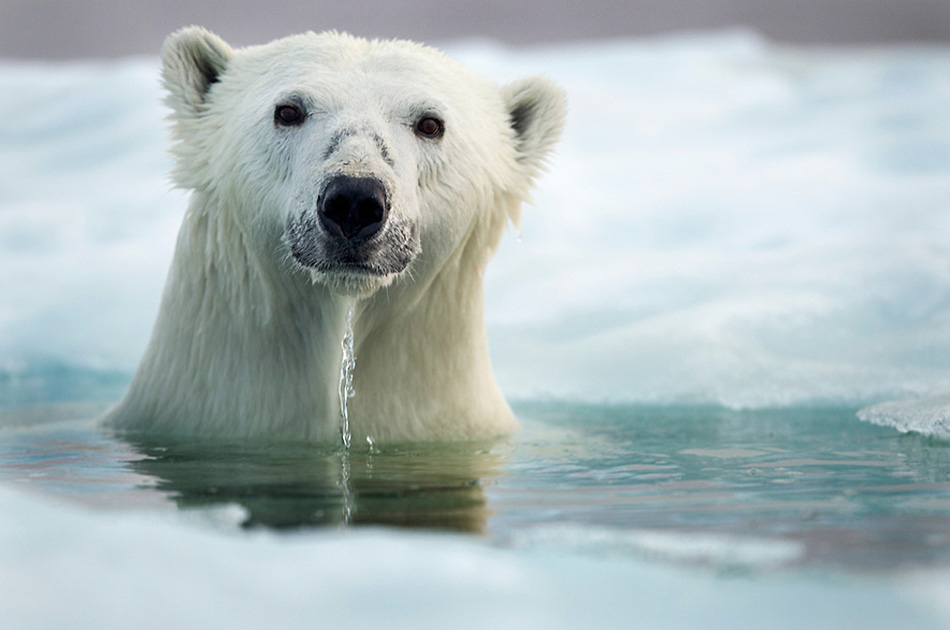
TID: Why? As a Personal Challenge? Conservation goal? Portfolio piece for more work? To win Inuit groupies?
Paul: There's never been a better time to be a nature photographer. The last decade's explosion of new digital photo technologies have brought perfect exposures and autofocus telephoto lenses to the masses, or at least anyone with a credit card and reckless financial priorities. Destinations and subjects that once took weeks or months of time to find and photograph are now available as luxury package tours. You don't have to work for National Geographic or a BBC film team to see some of the most amazing wildlife spectacles on earth. The flip side is that there's never been a worse time to make a living as a nature photographer. Anyone with the slightest sense of adventure can now go out in relative safety and comfort and make technically perfect images, and spread them around the internet for nothing more than bragging rights.
Polar bears are particularly tough. They're big and charismatic and as lovable an man-eating predator as you're likely to find. Churchill, Manitoba has been the polar bear watching capitol of the world for a generation. Everyone and their grandmother has been out on the Tundra Buggies to photograph the annual gathering of bears each fall.
Tempting though that spectacle is, from a business and professional perspective it doesn't make sense to go out and shoot the very same pictures that everyone else has done.
It's not that I'm cranky, antisocial and cheap. Although I am. If I'm going to continue working as a professional, I'll have to find new ways to tell these animals stories, and create new images that can compete in an overcrowded marketplace.
I wanted to go out on the water, in a small portable zodiac inflatable boat, on my own, to find and photograph bears as the ice on Hudson Bay began to melt and the bears headed for shore. It was a pretty formidable undertaking, and even as I got on the train to ride 600 miles north to Churchill, I had no idea if it was workable.
TID: What were some problems or challenges you encountered during the coverage of this event, and how did you handle them?
Paul: The biggest challenges were the most fundamental ones. How do I get there? Can I find any bears? Can I get back alive? What's for supper?
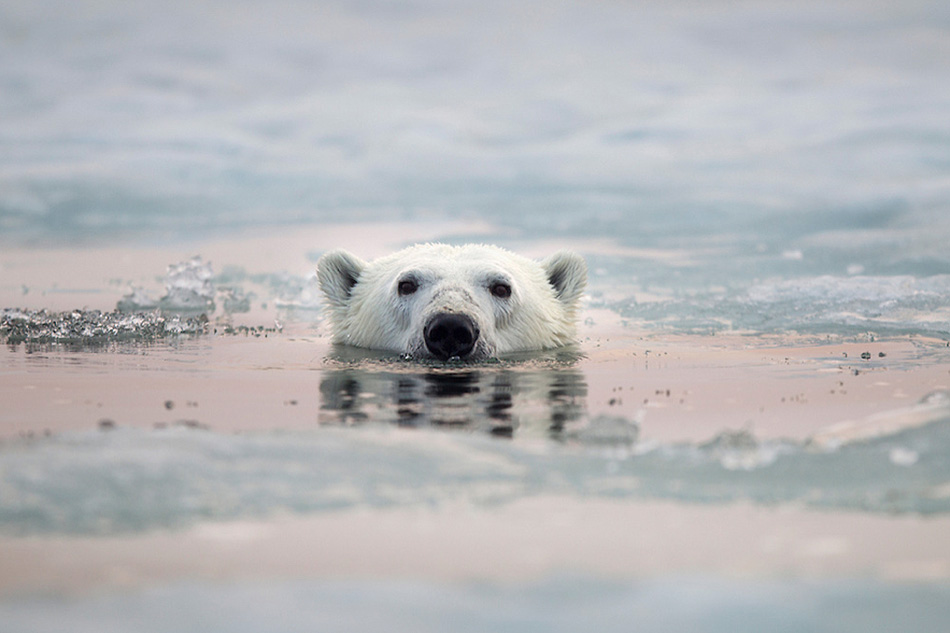
Paul: It was as simple as figuring out how do I carry all this gear halfway across the continent, to a place I've never visited and know next to nothing about, to do a project that, to my knowledge, has never been attempted. I've done a lot of zodiac expeditions before, but never in polar bear country. I spread out all of my gear in the garage, and then slowly pulled it all together. Boat gear. Outboard motor. Camping gear. Photo gear. Underwater gear. Dehydrated expedition meals. It was an enormous pile of stuff. I looked like a homeless survivalist hoarder.
TID: Although we don’t usually focus on gear, can you talk about how you thought about what gear was needed? Did you research what gear to bring? Were you telephoning a bunch of folks, doing online searches? Was it all based on previous experience?
Paul: There's a lot of emphasis these days on traveling light. I'm more of a kitchen sink packer. Actually, better bring a second sink, because I'll probably break the first one. Based on long and often sad experience, I wanted to cover all my bases. However hard it is to drag all this crap halfway across the continent, it's harder and more expensive to have spares and replacements flown in at the last minute. I've done a fair bit of boat and zodiac travel over the years, and have worked up a ridiculously long packing list of everything I might need out on the water in the arctic. I've found the right combination of inflatable boat (a 10 foot Zodiac air deck that weighs 70 pounds and can be packed up as airline baggage) and outboard motor (a 10hp Nissan outboard that I can just manage to carry on my shoulder). The same goes with the rest of my expedition kit, it's enough to keep me warm and alive in most any situations. And I carry along enough satellite communication gear to save my bacon if it all goes wrong.
As it turns out, Churchill has several perfectly nice hotels (and a big shout-out to the nice folks at the Polar Inn) and a grocery store. So I slept in a dry bed every night. But there was still a big physical element to the project. I had to manhandle the 75-pound zodiac to the water's edge. Then carry an 80-pound outboard motor. Then all my camera, underwater gear and survival supplies in heavy pelican cases. There's a 30-foot difference between the high and low tide on Hudson Bay, and if I timed it wrong, I'd have to carry everything more than a quarter mile just to get to the water. It could take more than an hour, and it was a lot of exercise for an old guy.
Then it was simply a matter of waiting for decent weather, and going out to the edge of the melting ice pack, pull out my binoculars and start looking for bears. I know from long experience that it's tough to spot polar bears out on the ice from any boat, but a zodiac is so low in the water, and so unsteady, that it's nearly impossible. Any time I could, I'd stop on the pack ice and climb the highest point, slowly circling and scanning through 360°, painstakingly examining each bump and nob on the ice. In two weeks, I saw only two bears.
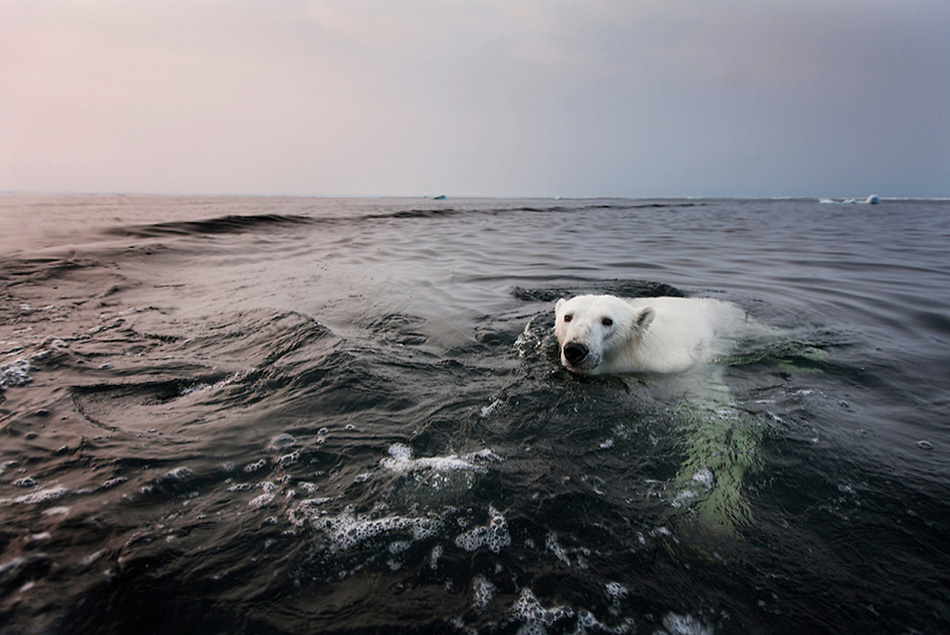
TID: Those aren’t exactly thrilling circumstance to work under. How did you stay mentally in-the-game? Coffee? Singing to yourself? Seriously, that seems difficult to stay sharp that long with no encouragement.
Paul: The two week figure is perhaps a little misleading. I worked my way up to going very far offshore. When I first arrived, the harbor was iced in and the locals I talked with were not exactly encouraging about my prospects for success, or survival. There were a number early summer storms that kept me in town. And I spent a lot of time shooting underwater images of the thousands of Beluga Whales. So really, I spent five or six days completely dedicated to the polar bear hunt. But it's a funny thing, I might not be all that smart, but I can be very, very stubborn. I knew the bears were out there somewhere. From my three sailboat trips to Svalbard, I had a good sense of the amount of time and level of concentration that it takes to find a bear on the ice. From experience, I can say that chances are greatly improved when you're not warm and comfy below decks sipping hot cocoa.
I spent 12-14 hours a day out on the water, as far as 30 miles from shore. If I started to think too hard about what I was doing, it started to work on my nerves. I was a very small speck in a very, very big pond, and no one knew where I was beyond the most general of terms. I did carry a GPS, satellite phone and emergency satellite beacon. But the last thing I wanted was having to call in a rescue helicopter. There were nights when I didn't get back to shore until two in the morning. In the long arctic twilight, there wasn't much trouble with darkness. But it made for some very long days.
TID: Can you describe what was going on in your mind as the image took shape, and then also what you were thinking when you made the image?
Paul: What kind of idiot would go to this kind of trouble, endure the cold and frustration, the danger and expense, to go shoot the exact same pictures everyone already has? As soon as I spotted the bear, I took a moment to remind myself of some of the different ideas I had and that I wanted to shoot, and then I tried to sort out my gear so that I had a chance to try shooting them. Sure, I had my 300/2.8 out on one body to shoot tight portraits of the polar bear on the ice, or swimming in the water. But that's the obvious shot and one I've done any number of times before. I really wanted to shoot something wide-angle, and even underwater. So I hauled out my surf housing and loaded a body and 15mm fisheye and set it out for me to use. I carried a six-foot Manfrotto boom and a small tripod head and and mounted a Canon 7D with a wide-angle zoom on it, along with a Pocket Wizard remote
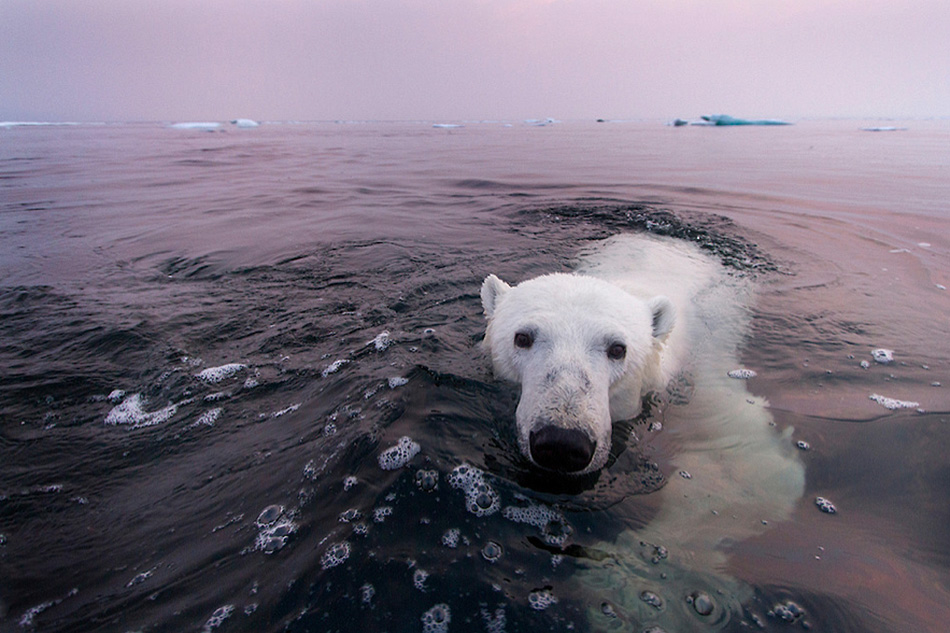
As the bear relaxed and grew curious, I was able to move parallel with her and close some of the distance between us. Eventually, I was very slowly motoring within 15 or 20 feet, and tried to hang the pole-cam out. This was one of those times when an extra set of hands to run the boat would have been handy. I tried to muscle the camera out while still keeping my other hand on the outboard and tiller, but managed to dunk the camera into water almost immediately. Shit. The saltwater shorted out the pocket wizard. I'd already torn apart my wired release for another project, and wound up chewing on the leads to exposure fresh copper wire to hand-wire it back together. All this while trying not to lose sight of my bear.

I watched her swimming toward an iceberg, then duck beneath it. As she popped her head up, I thought there might be a killer shot of her emerging from the water if I could get close enough with the wide-angle. I slowly motored around to the iceberg's near side, hung the camera out again and started shooting some frames from about ten feet away. I was in the boat and there was a good bit of ice between us, so I wasn't physically afraid. The one thought going through my head was "don't screw this up." I was worried that the camera wasn't firing, that the autofocus would catch on the distant ice and not her eyes, all of the things that might be going wrong. She popped her head up, took a breath and then ducked below the surface. With the camera hanging off the pole, I couldn't see what was going on, but I kept shooting. I had no idea that she was inches below the surface, peering back up at me. I just wanted to hold the camera steady and not drop it back into the water again.

She surfaced again, took another breath and swam away. I didn't see that frames of her looking back up at me for another week, until I was on the train home from Churchill. And then I went a little crazy, showing it to everyone on the train with me. It was just so much better than the shot I'd imagined.

TID: One of the reasons I approached you was because I had heard about this on-the-fly emergency fix. How often are you making plans and then having to improvise unexpectedly? Do you have suggestions for learning skills that often come in handy to you?
Paul: I wish I was one of those photographers who could pre-visualize my images, who could plan it all out and then execute flawlessly. I'm just not that guy. Coming from a newspaper background, we were taught to run and gun. I've learned to react quickly to whatever situation I'm in. Polar bears and other predators may have patterns, but predictable they are not. That's one reason I'll have three or four cameras spread out in the boat. I want to shoot a tight portrait. I want to have a wide angle in case he comes close and I can shoot him in the landscape. I need that underwater camera. And I was smart/lucky enough to have the boom with tripod head to hang a second wide-angle camera and hang it out a little closer.
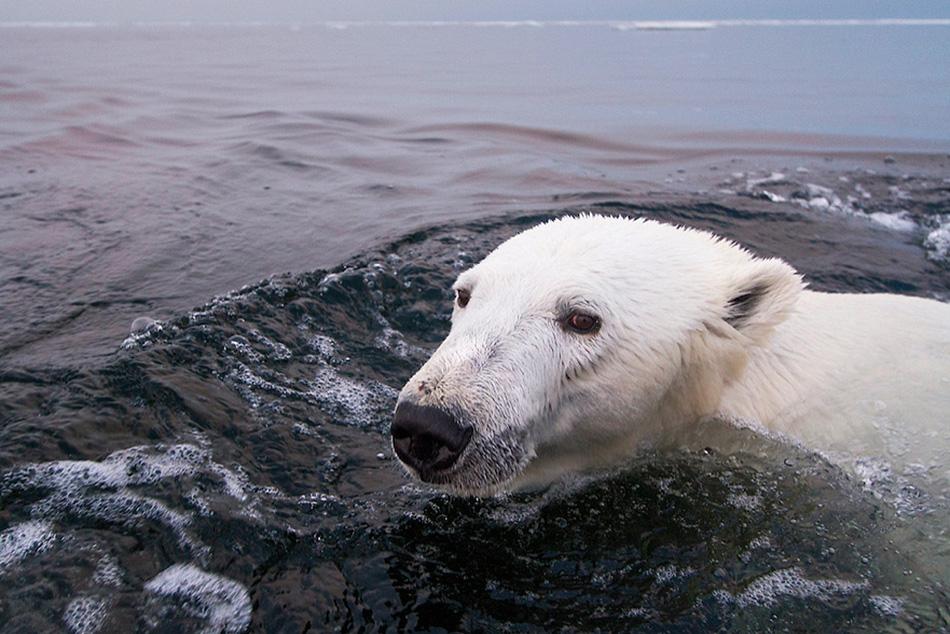
Paul: When I'm around a bear, I'm shooting all of the cameras as the situation dictates. And because the cold and saltwater are merciless killers of electronics, I'm used to swearing and banging away at cameras when they fail. And they do fail; constantly. It's incredibly frustrating, but a lot of it is my fault. Cameras and glass are repeatedly exposed to splashes and condensation, in spite of my best efforts to protect them in waterproof pelican cases.
The lesson I've learned is to have a spare handy, and know how to switch it all out in a hurry. I carry extra lens cloths, extra batteries, extra pocket wizards and cables and anything else that could leave me high and dry if it failed.
And at the end of one of these trips, I'm usually staring at a big pile of damaged gear and a large repair bill.
TID: Was there anything that you learned or put to use in later assignments that come about from this experience?
Paul: Based on this trip, I decided to bring a bigger boat up to Hudson Bay in the summer of 2013. I've used a 22-foot fiberglass cabin cruiser boat for years to explore the coastal waters of Alaska, and I pulled it on a trailer more than 2000 miles to the end of the road in Gillam, Manitoba last summer. I backed her into the Nelson River and then set off 75 miles downriver to reach Hudson Bay, and then spent six weeks motored more than 1500 miles up the west coast of Hudson Bay, all the way to the arctic circle, on a much more ambitious expedition. The boat is currently stored beside a local's sled dog lot, covered in snow, but I'm looking forward to heading back next summer to continue exploring in the Canadian arctic.
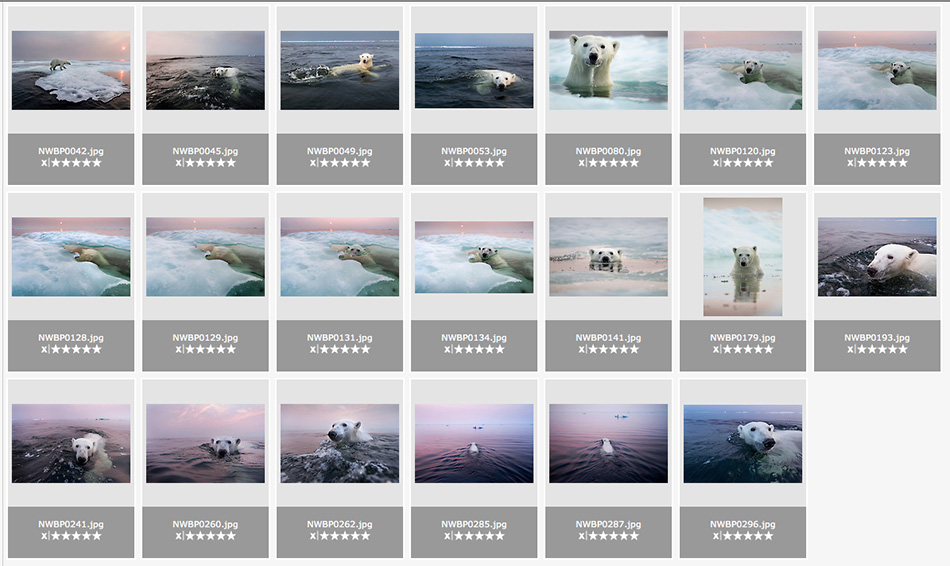
TID: This may be inappropriate, so feel free to decline: In seeing all this, I wonder how such an expedition fits into your overall business plan. When you plan and execute a trip like this, do you seek funding from past clients and partners? I know you do a lot of selling Stock imagery, so are these kind of events always a bit of a gamble or investment, where you are hopefully "planting seeds" that one day you can harvest? I know many photographers have Personal Projects that hurt their bottom line at first glance, but the exposure and attention this work garners gets them more paying work in the future.
Paul: Business plan? That's a good one.
I only wish I had a plan. I'm still pretending that you can make a living selling stock through the big agencies. And yet, somehow, it's still working (knock on wood). I do trips that sounds interesting, or challenging, or fun to me. I do try to keep expenses down these days, and think a little more strategically. The days of flying business class are sadly behind me.
And top ramen is surprisingly affordable, nutritious and tasty.
I think part of the reason I'm still able to make a go of it is that, in spite of all the sound business advice out there, I don't specialize. I like shooting asian megacity skylines nearly as much as I like shooting critters in the Costa Rican rainforest, as much as I like shooting the icebergs of Greenland or the penguins of Antarctica or bears in the arctic. And that diversity of subject matter means that I'm able to continue weather some of the stormy weather in the stock photo market.
To do the 2012 polar bear project, I spent a little over $4600 on gas, food, lodging and shipping costs. I already owned most of the expedition and boat gear. So far, I've had $19,255 in image sales. It's not lawyer or hedge fund money, but for a welder's son it's okay.
The bottom line is that I'm doing trips and projects because they interest me. I think they'll make good pictures, and I trust in my experience and ability and stubbornness that they'll pay off. It might take time, even years, but they almost always do.
TID: Any other thoughts?
Paul: I've never been a National Geographic photographer, and chances are vanishingly small that I ever will be. But nobody needs the Geographic's permission to go out and do these kinds of ambitious images and projects and stories.
Over the years I was happy to go out on my own dime and see the world that way. I don't have any of the financial or logistical or institutional backing that comes with a magazine assignment. On the other hand, I don't have to ask anyone's permission or sell any editors on my idea. I just go out and do it. Buy the plane ticket, rent the truck or charter the boat, and go shoot my pictures. Then come home and try to make my money back so I can do it all over again.
I go where I want, shoot what I want and come home when I'm done. And my wife is the only one who gets to yell at me over the satellite phone.
It's been a trade-off, and I sometimes wonder if it's been the right one. When I see what resources assignment shooters can bring to bear, the financial backing they receive and the impact that those pictures have when they are published in one of the world's most important magazine, I can't help but wonder...
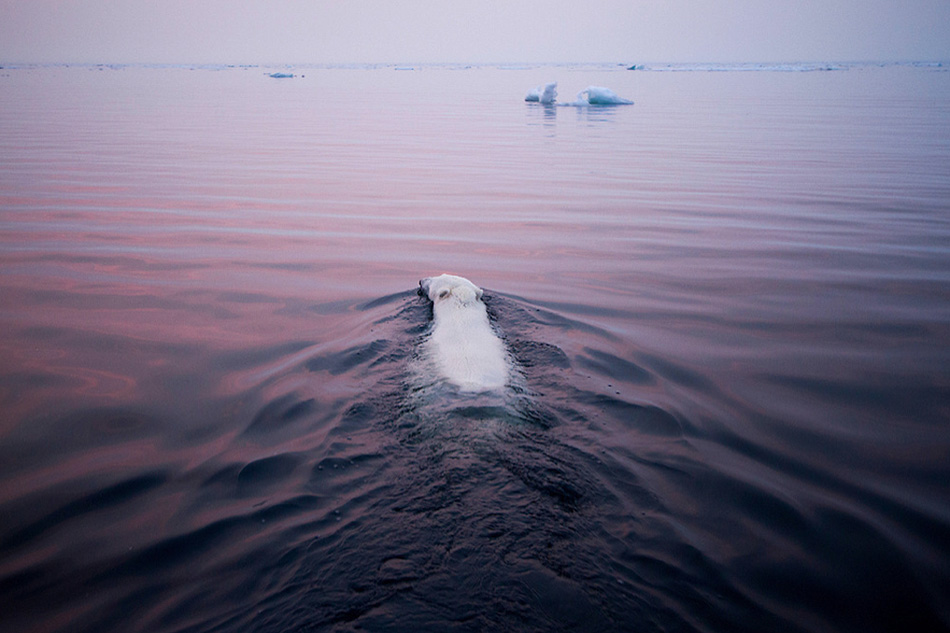
+++++++++++++++++++++++++++++
